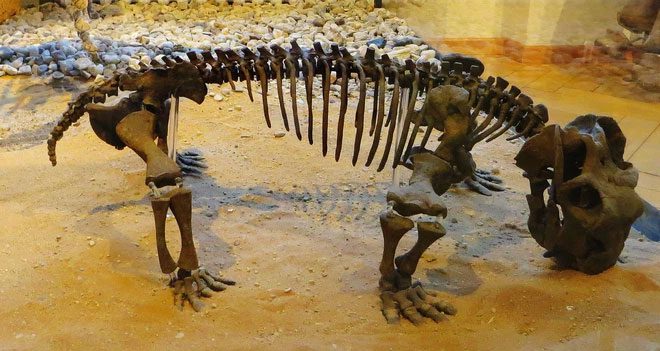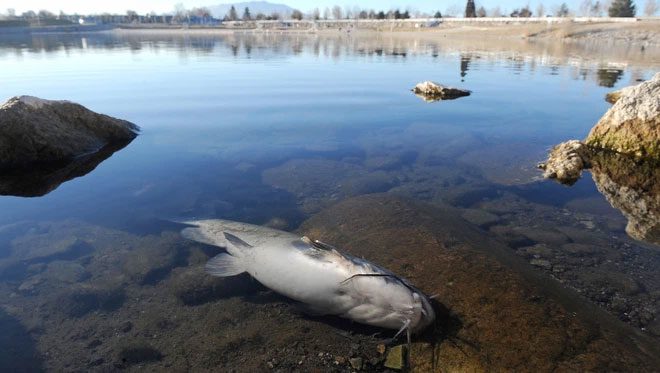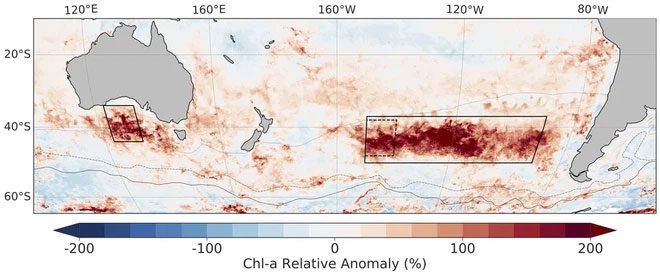If you live near a freshwater source, it’s highly likely you have witnessed harmful algae proliferating near the water’s edge, causing mass deaths among local wildlife. A new study indicates that these are warning signs showing that Earth is nearing an ecological disaster caused by humans, comparable to past extinction events that have occurred on the planet.
We have fossils that tell the story of about 251 million years ago, titled “The End-Permian Extinction Event” (abbreviated as EPE). This was a period during which 90% of species on Earth disappeared, making it one of the darkest phases of life on the Blue Planet.

The bones of Lystrosaurus, a vertebrate that managed to survive the planet-wide extinction event.
The phenomena that existed during the EPE extinction event are reappearing on Earth once more. This is the conclusion of a research team led by Chris Mays, a paleobotanist at the Swedish Museum of Natural History. The team discovered toxic algae and harmful bacterial blooms affecting aquatic species present during both the extinction event and modern freshwater sources. It is believed these issues arise from human activities such as greenhouse gas emissions, deforestation, and soil erosion.
“We are not at that threshold yet,” expert Mays wrote in an email, referring to the conditions necessary for a new extinction event to occur. “Perhaps carbon dioxide levels during the EPE were over six times higher than today, but current levels of carbon dioxide are not yet double those of pre-industrial times.”
“However, with the current rapid increase in atmospheric carbon dioxide, we are quite good at playing this game of catch-up. The rate of bacterial bloom events in water, alongside other extreme changing factors (such as major storms, floods, and wildfires), is also increasing, which further steepens the carbon dioxide slope.”
Two negative signs present in both the ancient extinction event and today’s Earth “are bad signals for future environmental changes,” the report published in Nature states. Indeed, there is substantial evidence suggesting that we are gradually heading toward another extinction event, this time caused by humans.

We are gradually heading toward another extinction event.
The explosion of bacterial populations not only transforms freshwater areas into “dead zones”, but also exacerbates the damage of extinction events and prolongs the recovery process of ecosystems by millions of years. Researcher Mays and colleagues reached this conclusion by analyzing fossils near Sydney, Australia. The rock layers present on Earth before, during, and after the extinction event illustrate part of the grim picture.
So far, the main reason for the EPE remains a mystery, but we know that ash from volcanic eruptions caused abrupt changes in global temperatures and greenhouse gas levels. Wildfires, droughts, and many other extreme phenomena engulfed forests, leading to massive plant die-offs.
The sudden disappearance of forests, one of the Earth’s carbon reservoirs, immediately impacts ecosystems. The once-fertile soil due to trees quickly erodes, and nutrients washed into freshwater sources help microorganisms in the water, which thrive due to high temperatures and carbon-rich air, to explode in numbers like never before.
Bacterial communities are an integral part of the global freshwater ecosystem, but the climate changes driven by human emissions – including wildfires, deforestation, erosion, and drought – are causing a new surge of algae.
“The three main components of this toxic soup are high greenhouse gas emissions, elevated temperatures, and abundant nutrients,” researcher Mays states. “During the EPE and other extreme events, volcanic eruptions provided the first two factors, while sudden forest loss created the third. Specifically: without green trees, soil erodes into rivers and lakes, providing nutrients for bacteria.”
“Today, humans are actively supplying all three of these factors. Carbon dioxide and global warming are inevitable byproducts of burning fossil fuels for hundreds of years, and we are also introducing a massive amount of nutrients into waterways, largely through agricultural and logging activities. These factors contribute to harmful algae blooms.”

Two algae blooms in the Pacific Ocean appeared after the devastating wildfires in Australia.
These actions pose a risk of creating dead zones, which not only lead to ecosystem collapse but also slow down the recovery process. These phenomena occurred during the End-Permian extinction event. The research team compared data and found similarities between the two timeframes.
“The concentration of algae during the End-Permian event, the worst mass extinction in Earth’s history, is similar to some of the recent algal blooms. However, these blooms during the EPE did not have human factors assisting them.”
“It turns out that extinction events can occur simply due to a sudden spike in greenhouse gases over a short period. Regardless of the source – whether from volcanoes, airplanes, or coal-fired power plants – the outcomes can be similar.”
Monitoring the development of algae in freshwater bodies around the world can help us predict the impact of the climate crisis in the coming decades and may explain why recovery rates are slow as dead zones become more prevalent. The research team is also examining the role of wildfires in the extinction event, specifically the disappearance of forests that once covered areas of South America and Siberia.
“As seen in the fossils, without areas that absorb excess carbon dioxide, the planet could warm abnormally for thousands of years,” researcher Mays states. “While wildfires play an important role in some ecosystems, I believe most scientists agree that preventing forest fires should be a top priority if we want to mitigate the impacts of global warming.”
“Unlike species that have experienced extinction events in the past, we have the opportunity to prevent harmful algae from proliferating by keeping our water sources clean and reducing greenhouse gas emissions.”


















































